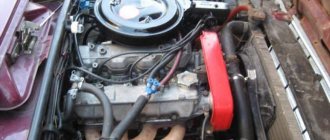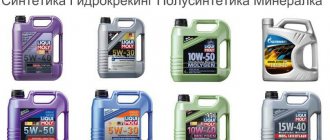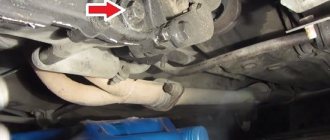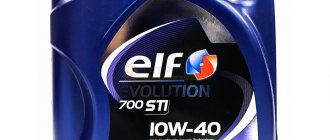Oil change intervals
Almost any driver knows the regulations for replacing technical fluids in his car, which are established by the manufacturer. But, in addition to the recommended timing, there are cases when the oil needs to be changed “unscheduled”. Such cases include, for example, carrying out a major engine overhaul or running-in. In the latter case, the oil change should occur after 3000 km. This is done in order to eliminate the consequences of break-in, that is, to remove chips from the engine.
Subsequent replacements are carried out after the car “passes” 10-15 thousand kilometers. Considering the quality of motor oils, it is recommended to do this more often, at least once every 8 thousand km.
Remember! The more often the engine oil is changed, the cleaner the engine is from the inside and the longer it retains its service life.
An oil change on a VAZ 2110 with a manual transmission is performed once every 40-60 thousand kilometers, and in an automatic transmission - every 60-80 thousand kilometers.
Why do you need to change the engine oil?
Few people can immediately describe all the functions performed by motor oil.
In fact, there are only three of them:
- Lubrication. The most important job of motor oil. In modern automobile engines, the loads on parts are very significant, hence the high requirements for engine oil. That is why modern motor oils contain high amounts of anti-friction, extreme pressure and viscosity-stabilizing additives (up to 20-30 percent). However, operation at high temperatures and contamination by gases breaking through the piston rings lead to aging of the oil - the effectiveness of the additive package decreases. The drop in viscosity of the engine oil is best seen: the used oil is much thinner than at the time of filling. A significant decrease in oil film strength, combined with aging of the anti-friction additive package, increases engine wear.
- Cleaning. Even the best oil cannot completely combat engine wear. It is important that the wear products of the friction pairs are retained by the oil so that they are retained by the oil filter. This is ensured by a package of detergent additives, which also do not last forever. Since the days when only low-quality mineral oils were available, there has been a common misconception that darkening of the oil means it is oxidized and needs to be replaced. In fact, the darkening of the oil is precisely the result of the work of a package of detergent additives, which allows the oil to retain all contaminants in its mass, preventing them from settling.
- Cooling. It is engine oil that cools the most heat-loaded engine components, for example, by spraying it onto the bottoms of the pistons. Thus, the oil is constantly in contact with parts heated above two hundred degrees, which accelerates its oxidation.
Required volume
Before buying motor oil, you need to decide on the volume. The best option is to purchase a 4-liter canister, which will last for a long time. This is convenient, because you can add the remaining liquid as the liquid is consumed, without worrying about buying a new one every time.
Well, now specifically about the one-time filling volume. The engine model plays an important role here. The VAZ 2110 used two engine variations. This is an 8-valve and 16-valve engine. In the first case, the volume of the oil sump is 3.2 liters, and in the second - 3.5 liters.
Manufacturer's recommendations.
Well, the most important thing that we immediately pay attention to is the manufacturer’s recommendation. Since only the manufacturer knows how many additives are in the oil, what base oil is and what the approximate service life of this oil is. It is very stupid to go against the recommendations, but still they are not always accurate. For example, Shell recommends changing oils of the ultra line at least every 15,000 km, and 10,000 km for the HX line. The original General Motors 5W-30 oil is recommended to be changed every 7-8 thousand km, although in my recent article, this oil can be maintained normally even after 10,000 km. And all these readings are during continuous driving, but in city conditions the engine idles a lot of time, and accordingly the oil life wears out much faster, so it’s worth making allowances for what your driving mode is, as well as your driving style. Some oils can withstand high speeds very well, these are mainly the premium line from well-known brands, and some do not really like high speeds (I mean long-term driving in this mode). Take, for example, the Mobil 1 line of oils. These oils can last from 10,000 to 20,000 km (according to the manufacturer’s recommendation), depending on the type of driving. If the driving is at least mixed, then I can guarantee that the oil will last 20,000 km, since I have a couple of taxi drivers I know who use this oil, and since a taxi car is the main source of income, they try take care of it (well, these are competent taxi drivers), so they take high-quality consumables and change them slightly exceeding the usual intervals. So there were no complaints about Mobil 1 even after a short run. One of them opened the cylinder head to eliminate a leak from the water in the head, and so the engine was very clean (this is from his words, I didn’t see it personally, but there’s no point in lying to him). About Shell specifically the ultra line, I personally drove up to 16,000 in the city, I didn’t take any further risks and changed the oil, but again referring to the article about GM after 10,000 km. Shell oil looked a little lighter in appearance, and there were no small particles to the touch, but still I didn’t check it until 20,000) I also used Motul, although after it I switched to Shell, because the engine somehow started to “rumble” with it later 2 years of use, but then a distributor I know told me that Motul had some kind of problem with the base oil, either they were supplied with low-quality oil, or they tried something in the recipe, well, in general, complaints began, like him said. Then everything seemed to be fixed, but I never returned. Regarding high speeds, Motul feels great there like no other, but they are less resistant to over-mileage than the top 2 manufacturers. 15,000 Motul comes out, but this is a highway. In the city you should not drive more than 10,000. About Total, Castrol, Lukoil I can say that more than 10,000 km on the highway, 8,000 in the city, as practice shows for clients, but they are better in price.
Rules for choosing oil
There are three basic rules for choosing engine oil for the “ten”:
- When purchasing, you must be able to distinguish a fake from the original. Counterfeit oils are a real problem in the modern car market. As a rule, those liquids that are counterfeited are those that have a high cost and are produced by famous brands. The use of such motor oils can have a detrimental effect on the engine.
- Every car owner should know about the approvals. Each car has its own motor oil tolerances, which determine the permissibility of using a particular liquid.
- Do not forget about the viscosity of motor oil, which depends on the region of operation, climate and weather conditions.
What to pay attention to
Now let's look at each of the above points in more detail. And first, let's return to fakes and understand the rules for identifying them. The easiest way to recognize it is to look closely at the canister. Even the slightest difference from the original will immediately reveal the efforts of the scammers. Non-original oil is also distinguished by another feature: the absence of a foil protective seal on the filler neck. It should be under the lid. If it is not there, the canister has already been opened, and not real oil was poured into it.
The optimal viscosity of engine oil for the VAZ 2110 is 5W40. Especially if the car is used with low mileage all year round. If the car is used quite often, for example in a taxi, then the oil should be selected according to weather conditions. In Russia, it is recommended to pour 0W30 in winter, and 10W40 or 15W40 in summer.
On a note! Sometimes, as an alternative to oil, regular mineral water is poured after break-in to save money.
A brief overview of the best motor oils
If a car owner finds it difficult to choose motor oil, it is recommended to pay attention to the following brands:
- Lukoil Lux. This is the cheapest motor oil for the VAZ 2110. It is recommended for use in cars with high mileage. Lukoil Lux is an ideal option for topping up, since the price of a liter canister is only 250-300 rubles. The oil has good cleaning properties, and, most importantly, no one will counterfeit a cheap liquid. After all, you must agree, this is unprofitable.
- Shell Helix HX8. This is a fairly high-quality oil for VAZ engines. Shell Helix has excellent lubricating properties and is ideal for all types of engines. It is more advisable to use this type of lubricant in an engine after a major overhaul or with a mileage of up to 200 thousand kilometers. In other cases, using this oil is a very dubious pleasure, since the price of a 4 liter canister is 2000 rubles.
- Elf. Not long ago Elf left the Renault assembly line, but was remembered as a good motor oil. Car owners began to pour it not only into popular foreign cars, but also into VAZ and
- Lada 110. To have a good effect, it is recommended to change Elf more often than required by the regulations. Ideally, it is recommended to reduce the frequency to 7-8 thousand kilometers.
Types of motor oils
Historically, mineral-based oils obtained from the distillation of petroleum were the first to appear. Sometimes it was mixed with castor oil (for example, this technology was used by Castrol, hence its name).
Such oils were sufficient for use in low-powered engines, although they had noticeable disadvantages: their viscosity depended significantly on temperature, mineral oils quickly oxidized and polluted the engine.
If the first problem was solved by creating seasonal oils (summer and winter), then the second was solved only by frequent replacement.
The development of the chemical industry has made it possible to stabilize and improve the properties of motor oils: thanks to viscosity modifiers, it was possible to create all-season mineral oils; a large number of anti-friction and detergent additives allow mineral oils to work successfully in highly loaded engines.
The payoff for the low price of mineral oil is the preservation of a weak point - a low resource, because, in addition to useful work, additive packages also counteract the negative qualities of the base oil itself.
Synthesis of base oil allows you to obtain a significantly higher quality product, but at a significantly higher price.
Synthetic motor oils, depending on the production technology, may have different compositions.
Polyalphaolefin oils are the most common - the technology for their production is the cheapest. However, in a number of qualities they are superior to polyester oils - for example, their volatility and flammability are much less, and their viscosity is more stable.
Manufacturers often use polyester oil as an additive to the polyalphaolefin base to improve the quality of the oil at a lower cost than all-polyester oil.
Mixing a synthetic base oil with a mineral oil produces the so-called semi-synthetic. In fact, such oils usually contain no more than 20% synthetic base oil. Such measures make it possible to obtain a more stable motor oil, increasing its service life compared to mineral oil, and also to stabilize its viscosity.
Oil change methods
Changing the lubricant can be done in two ways:
- with flushing;
- without rinsing;
The first is relevant when completely replacing the fluid and switching, for example, to another manufacturer.
With engine flush
Depending on the type of flushing, replacing engine oil can be divided into two types:
- 5 minutes. This is the most popular type of flushing. How is everything going? A special cleaning fluid is added to old motor oil. Then the motor is started for 5 minutes and allowed to run without load. After this, the old oil is drained along with the flush. This method is good because the old lubricant becomes more liquid and is easily removed from the engine along with the dirt.
- use of flushing oil. The use of this flushing option when performing a procedure such as changing the oil on a VAZ 2110 is performed as follows: the old oil is drained, then the oil filter is changed, and flushing fluid is poured into the engine. After this, the car must be driven a certain distance without heavy load. Then this oil must be drained and replaced along with the filter. This is a more expensive and high-quality type of washing.
Attention! Flushing the engine is done at your own risk. The fact is that caustic substances can raise coked dirt in layers and clog oil channels. Because of this, the oil pressure in the engine may drop. This is especially dangerous for 16 valve engines. In order to properly flush the engine and fill in a new type of engine oil, it is recommended to use a longer flush.
No engine flushing
If the type, brand and model of engine oil does not change, then the replacement is performed without flushing. To do this, the old oil is drained, the filter is unscrewed, a new one is installed and fresh lubricant is poured in. You don't need to do anything else.
Preparatory activities
To prepare for changing engine oil, you will need to collect the necessary materials, tools and take into account some of the features of this procedure.
- In order for more oil to leave the system, you need to start work immediately after a trip or with a warm engine. Just run it at idle speed for a few minutes. When oil is warm, it becomes more fluid. This allows the lubricant to drain as much as possible and eliminates the need for flushing.
- Only fill in the oil that was previously used in the engine. Not only the characteristics of the oil must match, but also its manufacturer and specific type.
- If you are switching to another type of oil, it is better to do a flush first. This is a simple, but useful and necessary procedure for the VAZ-2110.
You will also need replacement tools. The required list includes:
- spanners;
- dry rags;
- new filter;
- fresh motor lubricant
- puller key for the oil filter (you can do without it);
- pit or lift;
- funnel;
- container for used oil.
It is recommended to additionally use thick clothing, closed shoes and gloves. Since the oil is hot, when unscrewing the drain plug there is a possibility of liquid getting on your skin. Professionals easily cope with this task, but beginners get burns quite often. Therefore, be extremely careful.
Step-by-step instructions for changing the oil in a VAZ 2110
In order to change the engine oil on a VAZ 2110 without problems, you need to adhere to the following procedure:
- Place the car on a pit, lift or overpass. Warm up the engine to operating temperature.
- Unscrew the bolts securing the motor protection and remove it.
- Place a 4-liter container under the tray. A cut-off old canister works well for this.
- Unscrew the drain plug and let the old oil drain. While it is draining with both hands, you need to tear off the oil filter and dismantle it. If it does not unscrew, it is recommended to pierce it with a screwdriver and, using it as a lever, unscrew the old filter element.
- Install a new oil filter by first pouring a small amount of oil into it and lubricating the rubber band. Visually check that the filter valve is working properly.
- Replace the drain plug and screw on the protection.
- Fill in new engine oil to the level. Screw on the filler cap and start the engine. Make sure the pressure sensor goes out.
- Check the oil level after 3-5 minutes. If it is normal, there is no need to add it; if it is not at the level, it is recommended to drain the excess oil or add the missing oil.
The procedure is no different from the same one when changing the oil in a VAZ 2110 gearbox.
Preparatory activities
Before changing the oil, be sure to buy new fluid, purchase an oil filter and warm up the engine to operating temperature. You should also prepare a container for old motor oil. To make it, you need to cut the side of the canister along the perimeter to get a wide but spacious container. The same container will also be needed when changing the oil on a VAZ 2110 in a box.
Required Tools
To replace, you will need the following list of tools:
- A standard set of keys, of which you only need a 17-size open-end wrench for the drain plug and 8- and 10-size sockets for removing the crankcase protection.
- Additionally, it is recommended to purchase an oil filter puller, which is especially important if the oil is changed for the first time. After all, it is unknown at what point the old filter will be tightened.
- It is better to have a special funnel for filling in old oil.
Flushing the VAZ 2106 engine and adding new oil
As mentioned above, draining oil from a VAZ 2106 engine takes a lot of time. But as a rule, even this time is not enough to completely drain the waste. The reason is simple: oil, especially old oil, has increased viscosity. And a certain part of this viscous mass still remains in the small holes and channels of the motor.
Residues of engine oil that cannot be removed from the VAZ 2106 engine using a regular drain
In order to get rid of these residues, the driver will have to resort to the engine flushing procedure. It is best to wash the engine using regular diesel fuel.
Sequencing
- After the oil is completely drained from the car, the oil filter is manually removed. In its place, a new filter is screwed in, purchased specifically for washing (it will only be needed once, so you can save on its quality).
- The drain plug is closed and diesel fuel is poured into the engine crankcase. You will need the same amount of oil as oil, i.e. about 5 liters. After this, the filler neck is closed with a plug, and the engine is cranked using the starter for 10 seconds. You cannot fully start the engine (and to achieve maximum effect, the right rear wheel of the car can be raised 8–10 cm using a jack).
- After this, the drain hole on the crankcase is twisted again using a socket wrench, and the diesel fuel, along with the remaining waste, is drained into a substitute container.
- Complete drainage of diesel fuel takes 5–10 minutes. Now the drain plug is screwed in, and new oil is poured into the crankcase through the neck.
Video: the best way to flush the engine
Criteria for choosing the right oil
Before choosing the most suitable oil composition, you need to know all the information about the car:
- what year the engine was produced, its modification, as well as the degree of wear;
- how it is operated, what are the weather characteristics of the region;
- Does the engine have hydraulic compensators that regulate valve clearances?
The year of manufacture is important because older engines manufactured back in the 70s and 80s had oil seals, oil seals, and other sealing elements made of nitrile rubber. All parts made from this material do not tolerate oils based on synthetics or semi-synthetics. This disadvantage is eliminated by replacing them with imported ones made from rubber. True, this can also have negative consequences - if the motor power supply system is not entirely working. The fact is that gasoline, being a solvent, destroys rubber. So you need to be careful here. Additionally, if the valves have hydraulic compensators, they will require a lower viscosity lubricant. This applies to relatively new engines.
What engine oil is better to fill in the VAZ 2106 engine? In order to eliminate the error, you should refer to the vehicle’s service documentation. The permissible viscosity (SAE) should be indicated there, as well as the main characteristics (American API classifier, European ACEA or American-Asian ILSAC). If the Soviet GOST 17479.1-85 is indicated, lubricating compounds are divided into 6 categories:
Indexes have been added to categories B, C, D indicating belonging to carburetor systems (1) or diesel engines (2). If the index is not indicated, it means that the oil fluid is suitable for both types of engines. GOST designations are now rarely used because they are quite difficult to decipher.
Checking the oil level
Checking the oil level should be carried out after parking the car for a long time on a cold engine. It is best in the morning after parking the car overnight. If you check the oil with the engine just stopped, the level will be low. This is a normal phenomenon, since when the engine is running, oil from the sump under the influence of the oil pump is supplied to the cylinder head to lubricate the rubbing parts and does not have time to drain back into the sump so quickly.
Dipstick Lada Priora
Why change it?
Generally speaking, motor oil is a patient product. And if you create heavenly conditions for it - a clean, brand new engine, medium speeds, low loads (read: operation without overheating), then it will last longer than smart books say. But heaven is where we are not. In real life, oil begins to age literally from the moment it moves from a sealed canister into the labyrinths of the engine. Its oxidation begins, accelerated by constant heating and cooling, detergent additives leave, and dirt accumulates. There is nothing unexpected in all this: the oil must not only lubricate and cool, but also wash the engine, and also remove various impurities from it. But it is quite obvious that the rate of aging of motor oil greatly depends on its operating conditions.
Until recently, it was customary to specifically stipulate “severe operating conditions”, in which the engine oil had to be changed more often than during “normal” driving. This meant, first of all, mountain roads and unpaved roads, driving with a heavy trailer, etc. And then the list was replenished with the most formidable modern horror story - driving in traffic jams.
Why is such driving harmful to the oil? Yes, almost everyone! In the crankcase, it begins to deteriorate rapidly from contact with unburned fuel and crankcase gases that have escaped there. In this case, the oil temperature will rise due to the lack of airflow: oxidation will accelerate. Due to the inevitable growth of low-temperature deposits, increased oil contamination is guaranteed. And since at low rotation speeds the lubrication conditions in the cylinder-piston group worsen (low linear speed of movement - no oil wedge - wear increases), then all wear products in one concentration or another will necessarily end up in the oil. Iron, aluminum, chrome, you never know what else...
From the above, at least one thing should be clear: dozens more candidate theses will be written on this topic. Because there is no clear answer to the question of when exactly the engine oil needs to be changed. But not all cars have a magic warning light. And what she is guided by is a dark matter.
But we will try to do without candidate papers and without a light bulb.
What oil should I use?
What lubricant should I use? This is a key issue, especially when it comes to operating a car in the cold season. Many drivers have encountered a situation where the oil “freezes,” causing considerable trouble. Therefore, you should approach the choice of oil very seriously, without relying on advertising.
There is a myth that good lubricant is very expensive. This is wrong. Of course, advertised brands are more expensive, but among the budget domestic options there are worthy analogues that have excellent performance.
Lubricating oils are divided into mineral, synthetic and polysynthetic. Mineral options are low cost, but they are the ones most susceptible to temperature changes. Synthetic and semi-synthetic analogues are more resistant to Russian frosts and also better protect the car engine. The main selection criterion is the viscosity of the heat-resistant liquid. There is a viscosity classification, according to which there are summer, winter and off-season oils.










